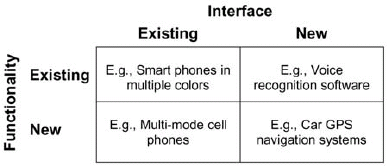Chapter 17. Consumer Adoption of Technological Innovations
Paschalina (Lilia) Ziamou
The City University of New York
The consumer adoption process refers to the process consumers use to determine whether or not to adopt an innovation. This process is influenced by consumer characteristics, such as personality traits and demographic or socioeconomic factors, the characteristics of the new product, such as its relative advantage and complexity, and social influences, such as opinion leaders (Gatignon and Robertson, 1991).
In the context of technological innovations, the adoption process is also influenced by one or several new technologies that are incorporated in the new product. New technologies are likely to significantly affect the innovation's functionality or interface. Functionality refers to the set of potential benefits that a product can provide the consumer. Interface refers here to the specific means by which a consumer interacts with a product to obtain a particular functionality (see, e.g., Ziamou and Veryzer, 2005). Specifically, new technologies suggest four types of innovations (see Figure 17.1) with unique characteristics that are likely to affect the adoption process.

Figure 17.1. Typology of technological innovations.
Existing functionality and existing interface
These innovations are incremental in nature since they offer an existing functionality and an existing interface; ...
Get Encyclopedia of Technology and Innovation Management now with the O’Reilly learning platform.
O’Reilly members experience books, live events, courses curated by job role, and more from O’Reilly and nearly 200 top publishers.

